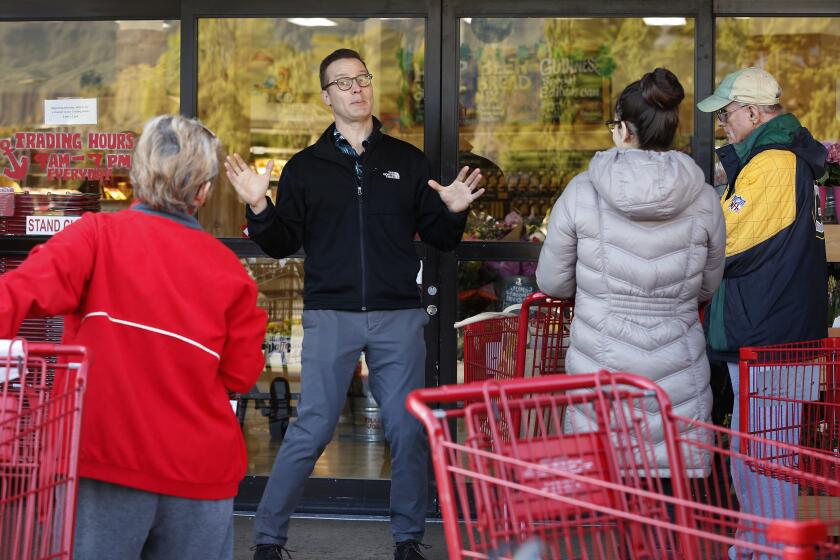Column: Here’s what’s wrong with Gov. Newsom’s stay-at-home order: It’s a legal mess

- Share via
There is little doubt about the overall wisdom of Gov. Gavin Newsom’s response to the coronavirus pandemic: On March 19, he ordered Californians to stay home for everyone’s good.
But the order’s legal adequacy is another matter. In fact, legally speaking, it’s something of a mess. As it drags on, it will chafe and even cripple many Californians. Some of them will react for their own good: They’ll sue.
And they may prevail.
For starters, the order, like others around the country, is the most expansive, even breathtaking, assertion of government power in at least 50 years in the U.S. It directly impinges on a series of fundamental constitutional rights, including the rights of association, travel and assembly.
Indeed, we colloquially call the order a “quarantine,” but in legal terms, quarantine refers to the isolation of people who have already been infected with a communicable disease. Newsom’s edict is far broader.
It’s not that the government can never infringe on constitutional rights. It can. But it has to be able to to show that it has a “compelling interest” for doing so, and that its action is the “least restrictive” means for achieving it.
This is the doctrine of strict scrutiny, which law professors like to call “strict in theory, fatal in fact” because it is so difficult for the government to satisfy.
Healthcare professionals are bravely battling coronavirus. But there are other “essential” workers in harm’s way. And they aren’t being paid fairly.
California surely has a compelling interest for acting to protect the health and safety of its citizens. The challenge for the state will be convincing the courts on the “least restrictive” question. And here California’s burden will be more difficult because, for totally understandable reasons, the governor’s order was hastily drafted, and its slapdash quality shows.
The Newsom order doesn’t even set out the terms of its shelter-in-place command. It rather consists of three prefatory paragraphs and an order to comply with a separate order of the state public health officer.
That order, in turn, says that Californians must stay home “except as needed to maintain continuity of operations” in 16 areas of federal infrastructure identified in yet another document issued by the Department of Homeland Security. Turning to that document, we find a list of sectors such as “chemical” “commercial facilities” and “healthcare” that themselves are far from precisely delineated.
What does it matter that the order is so circuitous and so fuzzy at the edges?
For one, it means that Californians are genuinely uncertain about what activities may transgress it. By its terms, the order allows only activity necessary to maintain operations of the 16 critical sectors. But that can’t be all that’s intended.
Indeed, the governor’s public statements and the information posted by the state take pains to permit activities not specified in the order. People can leave home to exercise, or walk their dogs, or buy supplies (as long as they maintain social distancing).
Meanwhile, police departments throughout the state have moved to reassure citizens that they actually don’t intend to enforce the order, which provides for misdemeanor violations or fines for those who don’t obey. Sound public policy perhaps, but there’s something wrong with a law that the police say they won’t enforce from the start.
We’ve already seen litigation in the current crisis. Last month, the city of Costa Mesa sued California to prevent the use of a former assisted living center to house and quarantine infected evacuees from the Diamond Princess cruise ship. The authorities backed away from the plan, though the two sides are back in negotiations.
And the ACLU’s National Security Project on March 13 advised that it “will be watching closely to make sure any use of emergency powers in response to the pandemic is grounded in science and public health, not politics or discrimination.”
Such suspicion and even resistance to state actions for “everyone’s good” is the contemporary American way. There are a handful of court cases (including the well known example of Mary Mallon, a.k.a. Typhoid Mary, in the early 1900s) in which challenges to quarantine orders were rejected. But they represent bygone times.
Since then, the courts have developed a large battery of individual rights, and Americans have learned to deploy them with relish. And government no longer commands a high level of fealty.
Op-Ed: A virus is raging. The economy is in free fall. Why Trump’s approval rating is still going up
Trump benefits from the “rally-round-the-flag” effect and because of bipartisan efforts to respond to the COVID-19 pandemic.
We can look, for instance, to New Jersey’s “abundance of caution” efforts in 2014 to quarantine a nurse who it believed had been exposed to the Ebola virus. She sued after being detained for three days. The courts sided with her: She posed no threat because she wasn’t symptomatic.
It’s just been a week since Newsom sent us all home from work and play, and the governor has a strong tailwind behind his order. Along with Gov. Andrew Cuomo in New York, he is perceived as providing steady leadership to fill the vacuum that the Trump administration has created with its dithering and lack of candor about COVID-19.
But in coming weeks, or months, someone will go to court over it. The judges and justices should approach those claims with considerable deference to the state’s emergency powers. But they can’t simply rewrite legally deficient orders.
That means there is one more “essential” activity not covered by the California edict: A lawyer in the state attorney general’s office had better get working to clarify its terms, and put in on the firmest possible legal ground, before the lawsuits start flying.
Harry Litman is a former U.S. attorney and host of the Talking Feds podcast. This is his first weekly column on legal affairs for The Times’ Opinion section. @harrylitman
More to Read
A cure for the common opinion
Get thought-provoking perspectives with our weekly newsletter.
You may occasionally receive promotional content from the Los Angeles Times.












